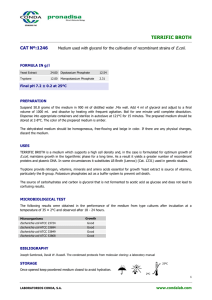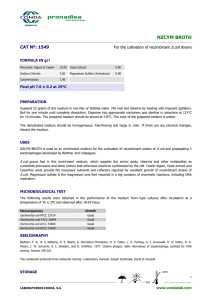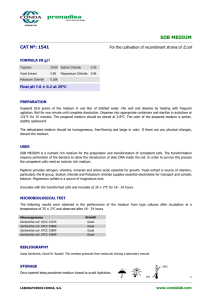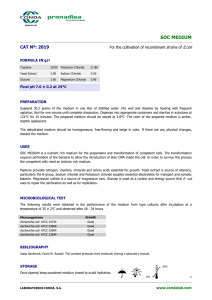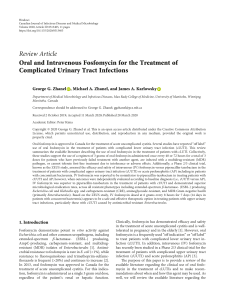PDF - OMICS Group
advertisement
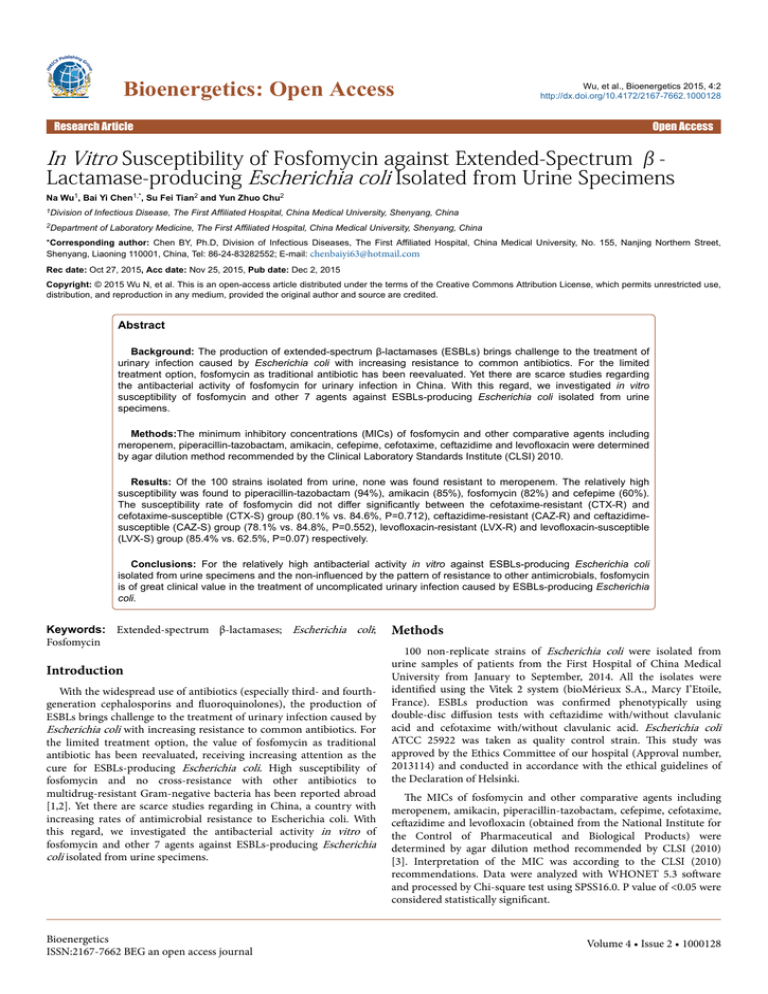
Bioenergetics: Open Access Wu, et al., Bioenergetics 2015, 4:2 http://dx.doi.org/10.4172/2167-7662.1000128 Research Article Open Access In Vitro Susceptibility of Fosfomycin against Extended-Spectrum βLactamase-producing Escherichia coli Isolated from Urine Specimens Na Wu1, Bai Yi Chen1,*, Su Fei Tian2 and Yun Zhuo Chu2 1Division of Infectious Disease, The First Affiliated Hospital, China Medical University, Shenyang, China 2Department of Laboratory Medicine, The First Affiliated Hospital, China Medical University, Shenyang, China *Corresponding author: Chen BY, Ph.D, Division of Infectious Diseases, The First Affiliated Hospital, China Medical University, No. 155, Nanjing Northern Street, Shenyang, Liaoning 110001, China, Tel: 86-24-83282552; E-mail: chenbaiyi63@hotmail.com Rec date: Oct 27, 2015, Acc date: Nov 25, 2015, Pub date: Dec 2, 2015 Copyright: © 2015 Wu N, et al. This is an open-access article distributed under the terms of the Creative Commons Attribution License, which permits unrestricted use, distribution, and reproduction in any medium, provided the original author and source are credited. Abstract Background: The production of extended-spectrum β-lactamases (ESBLs) brings challenge to the treatment of urinary infection caused by Escherichia coli with increasing resistance to common antibiotics. For the limited treatment option, fosfomycin as traditional antibiotic has been reevaluated. Yet there are scarce studies regarding the antibacterial activity of fosfomycin for urinary infection in China. With this regard, we investigated in vitro susceptibility of fosfomycin and other 7 agents against ESBLs-producing Escherichia coli isolated from urine specimens. Methods:The minimum inhibitory concentrations (MICs) of fosfomycin and other comparative agents including meropenem, piperacillin-tazobactam, amikacin, cefepime, cefotaxime, ceftazidime and levofloxacin were determined by agar dilution method recommended by the Clinical Laboratory Standards Institute (CLSI) 2010. Results: Of the 100 strains isolated from urine, none was found resistant to meropenem. The relatively high susceptibility was found to piperacillin-tazobactam (94%), amikacin (85%), fosfomycin (82%) and cefepime (60%). The susceptibility rate of fosfomycin did not differ significantly between the cefotaxime-resistant (CTX-R) and cefotaxime-susceptible (CTX-S) group (80.1% vs. 84.6%, P=0.712), ceftazidime-resistant (CAZ-R) and ceftazidimesusceptible (CAZ-S) group (78.1% vs. 84.8%, P=0.552), levofloxacin-resistant (LVX-R) and levofloxacin-susceptible (LVX-S) group (85.4% vs. 62.5%, P=0.07) respectively. Conclusions: For the relatively high antibacterial activity in vitro against ESBLs-producing Escherichia coli isolated from urine specimens and the non-influenced by the pattern of resistance to other antimicrobials, fosfomycin is of great clinical value in the treatment of uncomplicated urinary infection caused by ESBLs-producing Escherichia coli. Keywords: Extended-spectrum β-lactamases; Escherichia coli; Fosfomycin Introduction With the widespread use of antibiotics (especially third- and fourthgeneration cephalosporins and fluoroquinolones), the production of ESBLs brings challenge to the treatment of urinary infection caused by Escherichia coli with increasing resistance to common antibiotics. For the limited treatment option, the value of fosfomycin as traditional antibiotic has been reevaluated, receiving increasing attention as the cure for ESBLs-producing Escherichia coli. High susceptibility of fosfomycin and no cross-resistance with other antibiotics to multidrug-resistant Gram-negative bacteria has been reported abroad [1,2]. Yet there are scarce studies regarding in China, a country with increasing rates of antimicrobial resistance to Escherichia coli. With this regard, we investigated the antibacterial activity in vitro of fosfomycin and other 7 agents against ESBLs-producing Escherichia coli isolated from urine specimens. Bioenergetics ISSN:2167-7662 BEG an open access journal Methods 100 non-replicate strains of Escherichia coli were isolated from urine samples of patients from the First Hospital of China Medical University from January to September, 2014. All the isolates were identified using the Vitek 2 system (bioMérieux S.A., Marcy I’Etoile, France). ESBLs production was confirmed phenotypically using double-disc diffusion tests with ceftazidime with/without clavulanic acid and cefotaxime with/without clavulanic acid. Escherichia coli ATCC 25922 was taken as quality control strain. This study was approved by the Ethics Committee of our hospital (Approval number, 2013114) and conducted in accordance with the ethical guidelines of the Declaration of Helsinki. The MICs of fosfomycin and other comparative agents including meropenem, amikacin, piperacillin-tazobactam, cefepime, cefotaxime, ceftazidime and levofloxacin (obtained from the National Institute for the Control of Pharmaceutical and Biological Products) were determined by agar dilution method recommended by CLSI (2010) [3]. Interpretation of the MIC was according to the CLSI (2010) recommendations. Data were analyzed with WHONET 5.3 software and processed by Chi-square test using SPSS16.0. P value of <0.05 were considered statistically significant. Volume 4 • Issue 2 • 1000128 Citation: Wu N, Chen BY, Tian SF, Chu YZ (2015) In Vitro Susceptibility of Fosfomycin against Extended-Spectrum β-Lactamase-producing Escherichia coli Isolated from Urine Specimens. Bioenergetics 4: 128. doi:10.4172/2167-7662.1000128 Page 2 of 3 Results Discussion Results of susceptibilities of 8 antimicrobial agents against ESBLsproducing Escherichia coli isolates were shown in Table 1. Urinary infection is a common infectious disease infecting more than 150 million people each year worldwide, with the primary pathogen of Escherichia coli [4]. However, with the widespread use of antimicrobial drugs (such as third- and fourth-generation cephalosporins and fluoroquinolones), the detection rate of ESBLsproducing Escherichia coli has been ever increasing. The susceptibility rates of cefepime, cefotaxime and ceftazidime to ESBLs-producing Escherichia coli in this study have shown lower than other agents. Moreover, in our previous study, all of these three agents were deteced with inoculum effect, which means the the MICs of cephalosporins increase as the inoculum increase [5]. For the urinary infection caused by ESBLs-producing Escherichia coli, cefepime, cefotaxime and ceftazidime are not reliable even though the in vitro tests susceptible. Antimicrobial agent Susceptibility (%) MIC50 (μg/ml) MIC90 (μg/ml) Meropenem 100 0.03 0.03 Piperacillin/tazobactam 94 4 8 Amikacin 85 4 16 Fosfomycin 82 2 32 Cefepime 60 8 64 Cefotaxime 13 128 512 Ceftazidime 46 8 64 Levofloxacin 16 32 512 Table 1: Susceptibility of 100 ESBLs-producing Escherichia coli isolated from urine to 8 antimicrobial agents (%). Of the 100 strains isolated from urine, none was found resistant to meropenem showing excellent activity of carbapenem. The relatively high susceptibility was found to piperacillin-tazobactam (94%), amikacin (85%), fosfomycin (82%) and cefepime (60%). The MIC50 and MIC90 for fosfomycin were 2 μg/ml and 32 μg/ml respectively, by contrast cefepime reached 8 μg/ml and 64 μg/ml for MIC50 and MIC90. More than 50% of the isolates were not susceptible to cefotaxime, ceftazidime and levofloxacin. Table 2 showed the comparing of the susceptibility rates of fosfomycin between the cefotaxime-resistant (CTX-R) and cefotaxime-susceptible (CTX-S) isolates, ceftazidimeresistant (CAZ-R) and ceftazidime-susceptible (CAZ-S) isolates, levofloxacin-resistant (LVX-R) and levofloxacin-susceptible (LVX-S) isolates respectively. Strain group Susceptible of fosfomycin [n (%)] P CTX-Ra (n=76) 61(80.1) 0.712 CTX-S (n=13) 11(84.6) CAZ-R (n=32) 25(78.1) CAZ-S (n=46) 39(84.8) LVX-R (n=82) 70(85.4) LVX-S (n=16) 10(62.5) 0.552 0.07 Table 2: Comparison of fosfomycin susceptibility according to cefotaxime-resistant, cefazidime-resistant and levofloxacin-resistant in isolates. The susceptibility rate did not differ significantly between the CTXR and CTX-S group (80.1% vs. 84.6%, P=0.712), CAZ-R and CAZ-S group (78.1% vs. 84.8%, P=0.552), LVX-R and LVX-S group (85.4% vs. 62.5%, P=0.07). Bioenergetics ISSN:2167-7662 BEG an open access journal Meropenem showed good activity against Escherichia coli (100%), followed by piperacillin-tazobactam (94%) and amikacin (85%). However, owing to not only high expenses but also the selection of resistant bacterial for the long time use of carbapenems and βlactamase inhibitors, and the nephrotoxicity of aminoglycosides, it is necessary to consider other antimicrobial agent as therapy option. Hence, fosfomycin has started to get attention as a traditional antibiotic. Fosfomycin is a kind of phosphoric acid derivatives separated from streptomyces in 1969. It has a unique chemical structure and an unusual antibacterial mechanism of inhibiting the first step of bacterial cell wall synthesis. It can influence not only the reducing growth but also the property of adherence to uroepithelial cells, causing the defects of virulrnce [6]. This may explain the good activity of fosofmycin against Escherichia coli, especially for uropathogens. Recent researches have reported a high antibacterial activity of fosfomycin in the treatment of urinary infection [7]. In our study, 82% of ESBLs-producing Escherichia coli isolates being susceptible to fosfomycin was in accordance with that of Falaga’s investigation [1], which also pointed out that a particularly high concentration of fosfomycin could be maintained for a long time in urine. And also Mazzei et al. proves the effective by pharmacokinetic parameter of fosfomycin, finding its high urinary concentration with Cmax, 4415 mg/L [8]. Thus it could be considered in the treatment of uncomplicated urinary tract infection. Moreover, few reports involved the cross-resistance to fosfomycin with other antimicrobial agents, it may be due to the unique mechanism of chromosomal-resistance other than plasmid-mediatedresistance and the no substrate for multidrug efflux pumps [9,10]. Our study showed the susceptibility of fosfomycin is nearly 80% in both CTX-R and CTX-S group (with no significance), also with the same results in CAZ-R and CAZ-S group. To our surprise, the susceptibility of fosfomycin was higher in the LVX-R group than the LVX-S group, but also with the P value of no significance. Further investigations are warranted to investigate the mechanism. Conclusions Consequently fosfomycin shows a relatively high antibacterial activity in virto against ESBLs-producing Escherichia coli isolated from urine specimens and the non-influenced by the pattern of resistance to other antimicrobial agents. So with the increase of ESBLs, fosfomycin is of great clinical value in the treatment of uncomplicated urinary infection caused by Escherichia coli. However, whether there is synergistic effect with other antimicrobial agents in the treatment of severe cases remains to be investigated by further research. Volume 4 • Issue 2 • 1000128 Citation: Wu N, Chen BY, Tian SF, Chu YZ (2015) In Vitro Susceptibility of Fosfomycin against Extended-Spectrum β-Lactamase-producing Escherichia coli Isolated from Urine Specimens. Bioenergetics 4: 128. doi:10.4172/2167-7662.1000128 Page 3 of 3 Acknowledgment We thank subjects, and laboratory site staff for their support. References 1. 2. 3. 4. Falagas ME, Marki S, Karageorgopoulos DE, Kastoris AC, Mavromanolakis E, et al. (2010) Antimicrobial susceptibility of multidrug-resitant (MER) and extesively drug-resitant (XDR) Enterobacteriaceae isolates to fosmycin. Int J Antimicrob Agents 35: 240-243. Ko KS, Suh JY, Peck KR, Lee MY, Oh WS, et al. (2007) In vitro activity of fosfomycin against ciprofloxacin-resistant or extended-spectrum betalactamase-producing Escherichia coli isolated from urine and blood. Diagn Microbiol Infect Dis 58: 111-115. Clinical and Laboratory Standards Institute: Performance standards for antimicrobial susceptibility testing: twentieth information supplement (2010) In Document M100-S20. Wayne, PA: CLSI. Lee SJ, Lee DS, Choe HS, Shim BS, Kim CS, et al. (2011) Antimicrobial resistance in community-acquired urinary tract infections: results from the Korean antimicrobial resistance monitoring system. J Infect Chemother 17: 440-446. Bioenergetics ISSN:2167-7662 BEG an open access journal 5. 6. 7. 8. 9. 10. Wu N, Chen BY, Tian SF, Chu YZ (2014) The inoculum effect of antibiotics against CTX-M-extended-spectrum ß-lactamase-producing Escherichia coli. Ann Clin Microbiol Antimicrob 13: 45. Schito GC (2003) Why fosfomycin trometamol as first line therapy for uncomplicated UTI? Int J Antimicrob Agents 22: S79-S83. Patel SS, Balfour JA, Bryson HM (1997) Fosfomycin tromethamine. A review of its antibacterial activity, pharmacokinetic properties and therapeutic efficacy as a single-dose oral treatment for acute uncomplicated lower urinary tract infections. Drugs 53: 637-656. Mazzei T, Cassetta MI, Fallani S, Arrigucci S, Novelli A (2006) Pharmacokinetic and pharmacodynamic aspects of antimicrobial agents for the treatment of uncomplicated urinary tract infections. Int J Antimicrob Agents 28 Suppl: S35-S41. Arca P, Reguera G, Hardisson C (1997) Plasmid-encoded fosfomycin resistance in bacteria isolated from the urinary tract in amulticentre survey. J Antimicrob Chemother 40: 393-399. Nilsson AI, Berg OG, Aspevall O, Kahlmeter G, Andersson DI (2003) Biological costs and mechanisms of fosfomycin resistance in Escherichia coli. Antimicrob Agents Chemother 47: 2850-2858. Volume 4 • Issue 2 • 1000128

